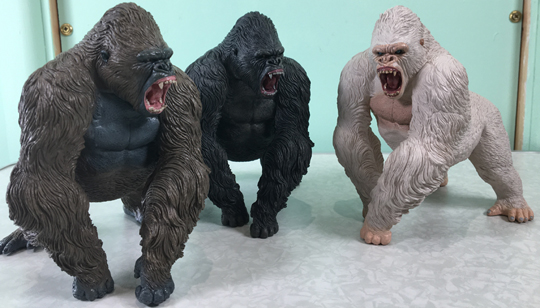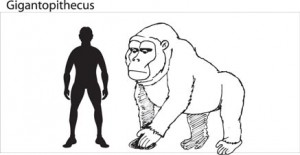Gigantopithecus the Inspiration behind the Famous King Kong
The Science Behind King Kong
The giant ape of the cinema screen known as King Kong, an ape that ruled Skull Island and then went onto to terrorise New York before meeting its end at the top of Empire State building, may be one of the most famous movie monsters of all time. However, the science surrounding giant apes is just as fascinating as anything penned by a Hollywood script writer.
Rebor Gorilla Models in Three Colour Variants

The three Rebor Alpha Mail Gorilla Z replicas Primal (left), Patriarch (centre) and Albino (right). Picture credit: Everything Dinosaur.
Picture credit: Everything Dinosaur
To view the Rebor range of models and figures: Rebor Prehistoric Animal Models and Figures.
King Kong
The first King Kong film was released in 1933, the stop-motion prehistoric animals that shared Skull Island with Kong, the giant ape, amazed cinema goers. The film, a parody of the fairy tale “beauty and the beast” was remade in 1976 and more recently Peter Jackson directed the CGI version which was released in 2005. Depending on which film you watch and which parts of which film you watch (as the 1933 King Kong was approximately 25 feet tall for the jungle scenes and then it grew to nearly 5o feet high for the scenes on the Empire State building), King Kong’s actual size is difficult to ascertain. Although it is almost certain that no gigantic hominid or simian creatures remotely near to King Kong’s size ever existed.
The fossil record for primates and early human ancestors is very incomplete although there is no evidence to suggest that giant gorillas roamed the planet in pre-history.
However, sometimes real life can reflect a fictional story depicted in a film. Just two years after the 1933 movie was released a German palaeoanthropologist called Ralph von Koenigswald purchased a very large molar (back tooth) from a Hong Kong pharmacy, whilst on a visit to China and the Far East. Fossils of all sorts were used in Chinese medicine, often described as “dragons teeth” or “dragons bone”. Koenigswald new differently and he correctly identified that the tooth belonged to a new, very large primate species. He went onto name the animal Gigantopithecus blacki.
An Illustration of G. blacki
Picture credit: Everything Dinosaur
Gigantopithecus blacki
Fossils of Gigantopithecus blacki (the name means gigantic ape), have been found in China and Vietnam. It lived during the Pliocene and Pleistocene epochs and males may have reached heights in excess of 3.2 metres tall (more than 10 feet high). A fully grown male might have weighed as much as five hundred kilogrammes, females were much smaller. This giant ape, the largest known in the fossil record to date, was a peaceful herbivore having a very similar diet to the extant gorillas of Africa today. The genus Gigantopithecus is known from a number of fossilised teeth and jawbones, very little of the post cranial skeleton material has been found.
It is likely that this large ape was encountered by hominids, early humans such as Homo erectus. Although best avoided, scientists have no evidence to suggest how aggressive or passive these animals were, but if extant great apes such as gorillas and orangutans provide a template, it is likely that this ape was secretive and was not very aggressive. Palaeoanthropologists believe that G. blacki was more closely related to Orangutans than to gorillas (a member of the sub-family for primates called the Ponginae).


